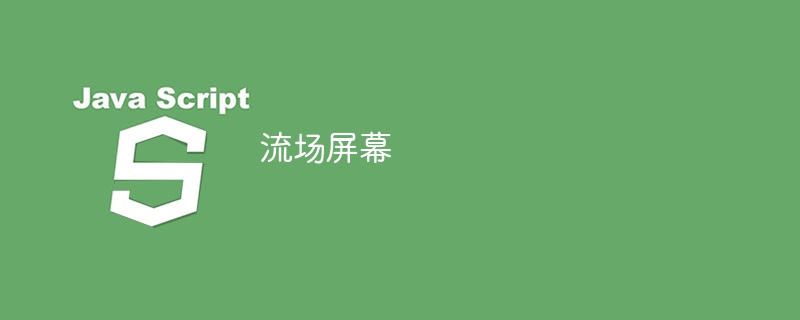
您是否曾被抽象粒子动画迷住过?这些流动、动态的视觉效果可以通过使用纯 javascript 和 html canvas 元素的极其简单的技术来实现。在本文中,我们将分解创建一个流场的过程,该流场为数千个粒子提供动画,让它们自然运动。
首先,我们需要三个文件:一个用于设置画布的 html 文件、一个用于样式设置的 css 文件以及一个用于处理逻辑的 javascript 文件。
<!doctype html>
<html lang="en">
<head>
<meta charset="utf-8">
<meta name="viewport" content="width=device-width, initial-scale=1.0">
<title>flow fields</title>
<link rel="stylesheet" href="styles.css">
</head>
<body>
<canvas id="canvas1"></canvas>
<script src="script.js"></script>
</body>
</html>
让我们添加一个简单的样式,为画布提供黑色背景,并确保删除所有内边距和边距。
* {
margin: 0;
padding: 0;
box-sizing: border-box;
}
canvas {
background-color: black;
}
particle类是动画的核心所在。每个粒子在画布上移动,留下其过去位置的痕迹,创造出流动的效果。
class particle {
constructor(effect) {
this.effect = effect;
this.x = math.floor(math.random() * this.effect.width);
this.y = math.floor(math.random() * this.effect.height);
this.speedmodifier = math.floor(math.random() * 5 + 1);
this.history = [{ x: this.x, y: this.y }];
this.maxlength = math.floor(math.random() * 200 + 10);
this.timer = this.maxlength * 2;
this.colors = ['#4c026b', '#8e0e00', '#9d0208', '#ba1a1a', '#730d9e'];
this.color = this.colors[math.floor(math.random() * this.colors.length)];
}
draw(context) {
context.beginpath();
context.moveto(this.history[0].x, this.history[0].y);
for (let i = 1; i < this.history.length; i++) {
context.lineto(this.history[i].x, this.history[i].y);
}
context.strokestyle = this.color;
context.stroke();
}
update() {
this.timer--;
if (this.timer >= 1) {
let x = math.floor(this.x / this.effect.cellsize);
let y = math.floor(this.y / this.effect.cellsize);
let index = y * this.effect.cols + x;
let angle = this.effect.flowfield[index];
this.speedx = math.cos(angle);
this.speedy = math.sin(angle);
this.x += this.speedx * this.speedmodifier;
this.y += this.speedy * this.speedmodifier;
this.history.push({ x: this.x, y: this.y });
if (this.history.length > this.maxlength) {
this.history.shift();
}
} else if (this.history.length > 1) {
this.history.shift();
} else {
this.reset();
}
}
reset() {
this.x = math.floor(math.random() * this.effect.width);
this.y = math.floor(math.random() * this.effect.height);
this.history = [{ x: this.x, y: this.y }];
this.timer = this.maxlength * 2;
}
}
effect 类处理粒子的创建和流场本身,它控制粒子的运动。
class effect {
constructor(canvas) {
this.canvas = canvas;
this.width = this.canvas.width;
this.height = this.canvas.height;
this.particles = [];
this.numberofparticles = 3000;
this.cellsize = 20;
this.flowfield = [];
this.curve = 5;
this.zoom = 0.12;
this.debug = true;
this.init();
}
init() {
this.rows = math.floor(this.height / this.cellsize);
this.cols = math.floor(this.width / this.cellsize);
for (let y = 0; y < this.rows; y++) {
for (let x = 0; x < this.cols; x++) {
let angle = (math.cos(x * this.zoom) + math.sin(y * this.zoom)) * this.curve;
this.flowfield.push(angle);
}
}
for (let i = 0; i < this.numberofparticles; i++) {
this.particles.push(new particle(this));
}
}
drawgrid(context) {
context.save();
context.strokestyle = 'white';
context.linewidth = 0.3;
for (let c = 0; c < this.cols; c++) {
context.beginpath();
context.moveto(c * this.cellsize, 0);
context.lineto(c * this.cellsize, this.height);
context.stroke();
}
for (let r = 0; r < this.rows; r++) {
context.beginpath();
context.moveto(0, r * this.cellsize);
context.lineto(this.width, r * this.cellsize);
context.stroke();
}
context.restore();
}
render(context) {
if (this.debug) this.drawgrid(context);
this.particles.foreach(particle => {
particle.draw(context);
particle.update();
});
}
}
为了让一切正常工作,我们需要一个动画循环来不断清除画布并重新渲染粒子:
const effect = new Effect(canvas);
function animate() {
ctx.clearRect(0, 0, canvas.width, canvas.height);
effect.render(ctx);
requestAnimationFrame(animate);
}
animate();
通过分解 particle 和 effect 类,我们仅使用普通 javascript 创建了流体和动态流场动画。 html 画布的简单性与 javascript 的三角函数相结合,使我们能够构建这些令人着迷的视觉效果。
随意使用粒子数、颜色或流场公式来创建您自己的独特效果!
以上就是流场屏幕的详细内容,更多请关注php中文网其它相关文章!

每个人都需要一台速度更快、更稳定的 PC。随着时间的推移,垃圾文件、旧注册表数据和不必要的后台进程会占用资源并降低性能。幸运的是,许多工具可以让 Windows 保持平稳运行。

Copyright 2014-2025 https://www.php.cn/ All Rights Reserved | php.cn | 湘ICP备2023035733号